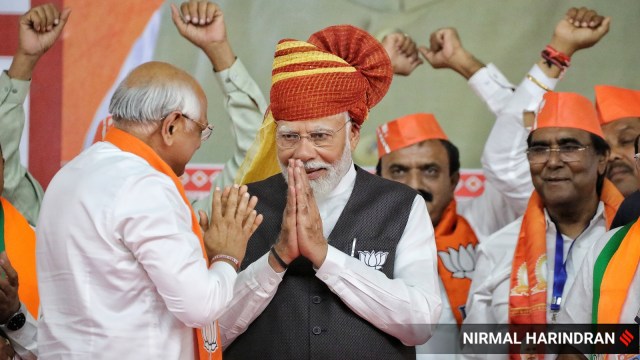
The parliamentary election of 2024, otherwise being described “dull” or “waveless”, has seen an exciting and rather unpredictable campaign in Gujarat. In a state where the Narendra Modi-led BJP has been the dominant political force for over two decades now, the outcome of any election, leave alone one which has Modi on the ticket (seeking a third straight term as the prime minister) becomes quite predictable and hence less exciting for political observers. The campaign for 2024, however, has been quite the opposite.
From the statewide agitations spearheaded by the Kshatriya community against comments made by BJP’s Rajkot candidate Parshottam Rupala, to the mobilisation of the tribal youth in Bharuch, led by Aam Aadmi Party’s Chaitar Vasava, the INDIA bloc candidate from the constituency, to the intensive campaign led by “Banas ni ben”, Congress’ Geniben Thakor in Banaskantha in North Gujarat, the different ways in which the Opposition has challenged the BJP’s electoral dominance has created ripples. For many pollsters and observers, having witnessed the near-complete electoral rout of the Congress by the BJP in the state assembly elections held in December 2022 — where the BJP got 156 seats out of 180 and more than 50 per cent of the vote share — the parliamentary election might have seemed like a walk in the park for the ruling party. However, the Opposition’s campaign managed to install a few roller coasters to give the ruling party some unexpected jitters.
Polarisation politics
Beyond the rhetoric and symbolism, there are three ways to look at the electoral discourse that has emerged from Gujarat over the past month. The first is that the conflict between caste and development is out in the open. The idea of development or vikas being the fulcrum of political narrative, whether in the form of the Gujarat model or viksit Bharat, has been shown as having limited usability. Whether it is PM Modi warning voters at public rallies that their buffaloes would be stolen by Congress or whether it is leaders of the Kshatriya community launching statewide agitations over “hurt sentiments”, the focus of the discourse has been on polarisation along community and caste lines. The fragmented nature of the Kshatriya agitation which has seen more support from the lower OBC Kshatriyas as against the upper caste “Sanskritised” Kshatriya communities, which have mostly extended their support to Narendra Modi, also exposes the complexity of caste and region.
It has also brought to the fore inter-community rifts, especially those between the dominant Patidars (who are seeking OBC status) and Kshatriyas (from the lower OBC groups). Such social cleavages were expected to have been filled in by the development model of “sabka saath, sabka vikas”; however, they seem to have been exacerbated due to a Brahmin-Baniya-Patidar dominated model of development, that was able recapture the levers of state power after a successful but short-lived challenge to their dominance by the KHAM (Kshatriya Harijan Adivasi Muslim)-based mobilisation of Jinabhai Darji in the 1970s and 1980s. The re-establishment of the Brahmin-Baniya-Patidar troika coincided with the rise of Hindutva politics in Gujarat which has been the dominant political force in the state, at least since 1995.
Youth leaders
Second, the co-option of youth leaders like Hardik Patel and Alpesh Thakor by the BJP has opened up space for the likes of Chaitar Vasava to emerge as youth leaders from the Opposition. However, the regional and spatial marginalisation of the tribal regions and South Gujarat from the rest of Gujarat prevents a leader like Vasava from resonating with the disgruntled youth in the rest of Gujarat. The young voters of Gandhinagar, Mehsana, Rajkot and Jamnagar, who are unhappy with frequent paper leaks, lack of jobs, unavailability of good higher education infrastructure and lack of opportunities to obtain higher skills, are unable to articulate their unrest in meaningful ways as the avenues of political expression to their voices seem to be highly restricted. This is remarkable for a state which saw the participation of students, including many from the ABVP, in the Navnirman movement in 1973-74 that led not only to the toppling of the Chimanbhai Patel-led Congress government in the state. It had nationwide ramifications in the form of the “sampoorna kranti” or total revolution led by Jayaprakash Narayan against Indira Gandhi.
It is important to understand that while the Prime Minister is particularly interested and invested in cultivating the constituency of young voters and first-time voters to enjoy the electoral dividend from this demography — even giving awards to social media influencers — the politics in his home state is stifling the active participation of youth in electoral politics by relegating their issues to the margins.
Money power
Third, and most importantly, the BJP has been more successful in integrating and accommodating different communities into the varied structures of regional political economy than other political parties. This is evident in the choice of candidate from Banaskantha. Standing against the formidable Geniben Thakor is Rekha Choudhary, a Choudhary-Patel whose grandfather started the Banas Dairy Co-operative, the largest economic resource of the district and Asia’s largest co-operative milk dairy. With increasing dominance over all the dairy and other cooperatives under its control, the BJP has integrated structures of regional political economy into levers of electoral mobilisation.
Geniben’s fight might be spirited, with appeals for crowd-funding and a ground-level connect with members of the constituency, but in times when money power plays an important role for substituting organisational deficits — like the one that plagues the Congress party, particularly in Gujarat — the BJP’s unlimited resources, in addition to its unparalleled organisation, makes the outcome predictable in some ways, even if the campaign has been unpredictable.
The writer is Assistant Professor, Ahmedabad University


